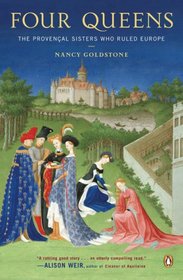Helpful Score: 3
In Four Queens, Nancy Goldstone tells the obscure but fascinating true story of the four daughters of 13th century Provençal count Raymond Berenger V, each of whom became a queen. Marguerite wed Louis IX, King of France; Eleanor was the wife of Henry III, King of England; Sanchia (Cynthia) wed Henrys brother Richard, Earl of Cornwall and later King of the Romans (modern-day Germany); and Beatrice married Louis brother Charles, Count of Anjou and later King of Sicily (modern-day southern Italy).
Its an amazing story, but its tough going. First, the 13th-century setting is unfamiliar to most modern readers. The geopolitical divisions of the British Isles and European land mass bear little resemblance to modern maps, and the situation is complicated by the fact that many of the different characters in the drama bear the same first names. There are multiple Charleses, Simons, Raymonds, Beatrices, Eleanors, and Isabelles. The reader frequently has to stop and straighten out the cast of characters before proceeding.
Further complicating matters is that the reigns of the monarchs were more or less consecutive. Goldstone chooses to jump from one court to another, covering the same timeline multiple times, each time focusing on the activities of one of the sisters. Its a real chore to map a direct timeline across the 70-some years when the action is frequently interrupted by meanwhile, back at the ranch interludes.
Having said all that, the real meat of the story lies in the power plays, manipulations, money troubles, greed, ambition, jealousy, and double dealings of the major players, their parents, spouses, cronies, offspring and let us not forget the Pope (there are several during the books time span) who keeps popping up as referee, financier, ally, enemy, warrior, and no mean political gamesman himself.
Its a worthwhile read, but the reader may require several runs at it before fully understanding the tale. And by the way, if they ever made a TV series of this, it would blow Dallas, Dynasty, Falcon Crest and all those namby-pamby family sagas right off the tube.
Its an amazing story, but its tough going. First, the 13th-century setting is unfamiliar to most modern readers. The geopolitical divisions of the British Isles and European land mass bear little resemblance to modern maps, and the situation is complicated by the fact that many of the different characters in the drama bear the same first names. There are multiple Charleses, Simons, Raymonds, Beatrices, Eleanors, and Isabelles. The reader frequently has to stop and straighten out the cast of characters before proceeding.
Further complicating matters is that the reigns of the monarchs were more or less consecutive. Goldstone chooses to jump from one court to another, covering the same timeline multiple times, each time focusing on the activities of one of the sisters. Its a real chore to map a direct timeline across the 70-some years when the action is frequently interrupted by meanwhile, back at the ranch interludes.
Having said all that, the real meat of the story lies in the power plays, manipulations, money troubles, greed, ambition, jealousy, and double dealings of the major players, their parents, spouses, cronies, offspring and let us not forget the Pope (there are several during the books time span) who keeps popping up as referee, financier, ally, enemy, warrior, and no mean political gamesman himself.
Its a worthwhile read, but the reader may require several runs at it before fully understanding the tale. And by the way, if they ever made a TV series of this, it would blow Dallas, Dynasty, Falcon Crest and all those namby-pamby family sagas right off the tube.
Peggy M. (ladywing) reviewed Four Queens: The Provencal Sisters Who Ruled Europe on + 25 more book reviews
Helpful Score: 3
While the book is a little slow going in order to get all the players in order, it shows a good picture of life in the middle ages for those who are titled. I think Goldstone does a nice job of showing the relationship between the four sisters. What I found most interesting was some insight into the politics of the period. My initial curiosity in the book was piqued when I had found the Berenger family in my family tree. The way we think of those in power now, versus the way they were in the middle ages is very much different even though there are some similarities too.
4 sisters become some of the most powerful women in Europe. Unknown story to most of us, thus changing the impression that the women of the time were weak and inconsequential pawns of the royals and Lords they married. I couldn't put it down!
Goldstone gives us the historical facts pertaining to the remarkable marriage contracts and lives of four sisters. The Count and Countess of Provence have four daughters who become Queens in the 13th century. Marguerite marries Louis IX, becoming Queen of France; Eleanor marries Henry III becoming Queen of England; Sachia marries Richard, Earl of Cornwall, eventually becoming Queen of the Romans (Germany); and Beatrice marries Charles of Anjou to later become Queen of Sicily. Sections of the book are devoted to each with some overlap and it got quite confusing at times due to so many of the players having the same names...(there seems to be NO originality when naming infants in the middle ages). Personally I like my history a little less formal, more in the style of the Penman and Chadwick historical fiction novels. I would more recommend this to the staunch historian or someone interested in the surprisingly influential female roles of the royal courts of this time in Europe.
Intelligent historical fiction that is a very interesting read. Author weaves a story of political and courtly intrigue, which the reader is sure to enjoy.




